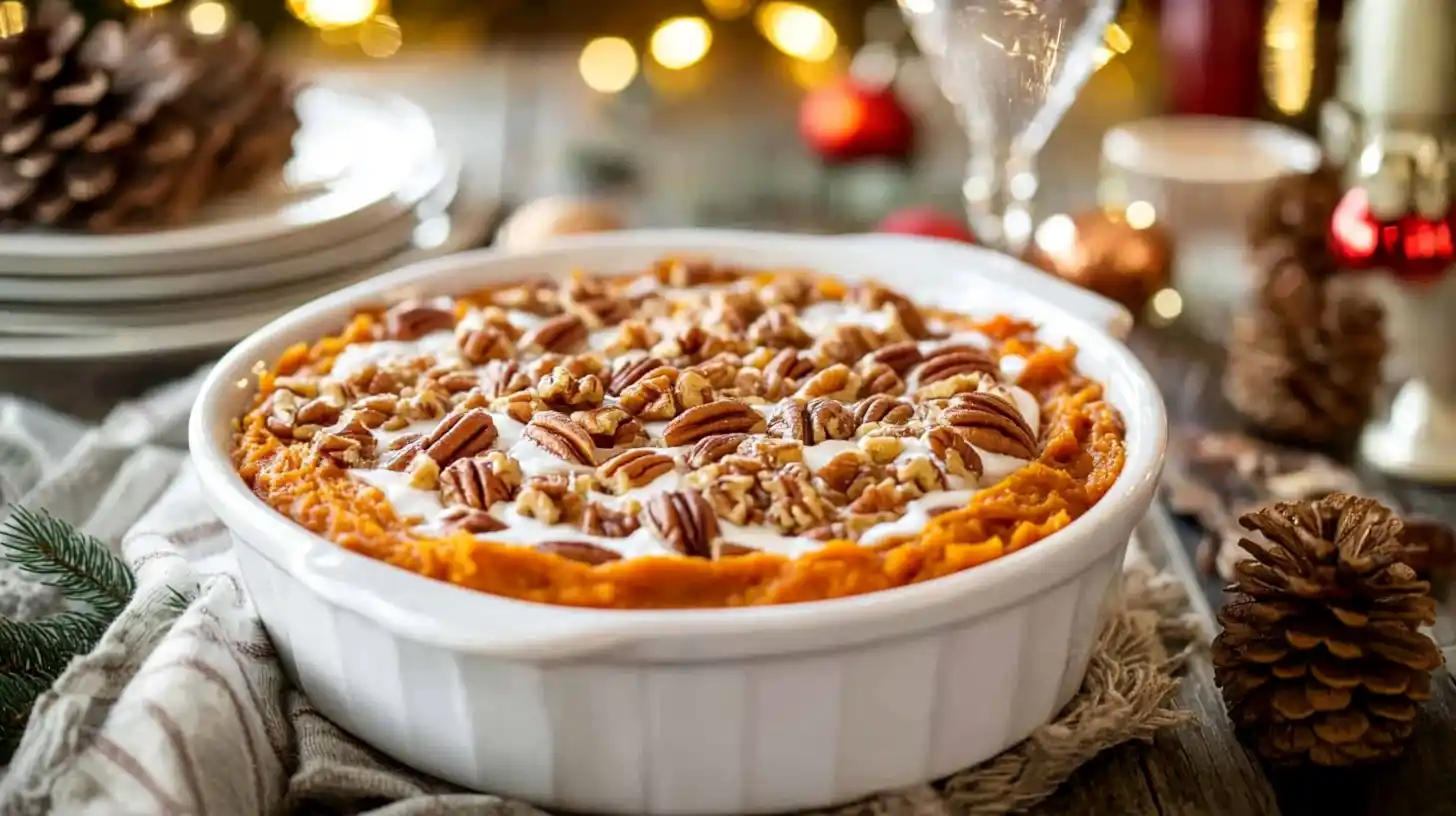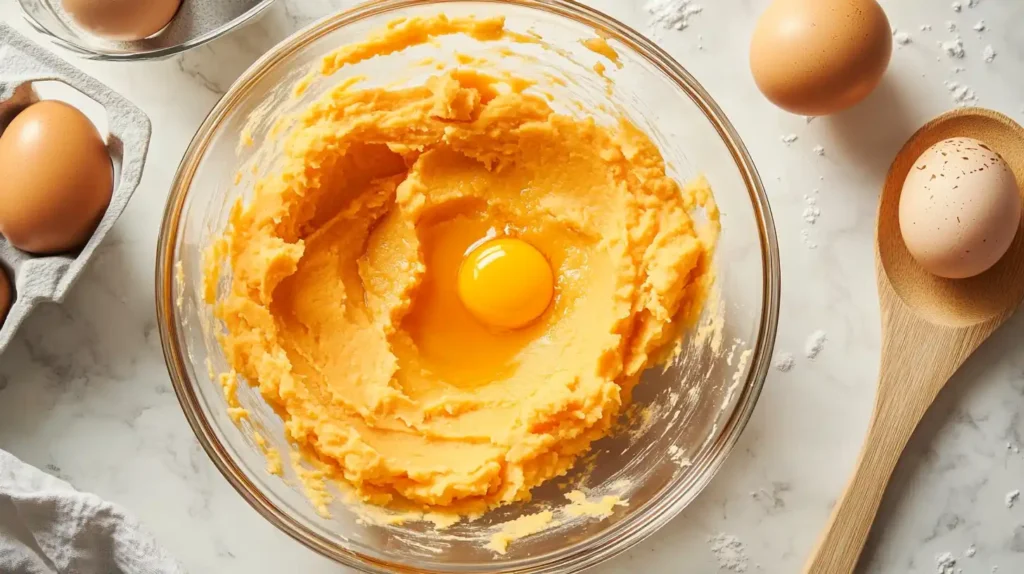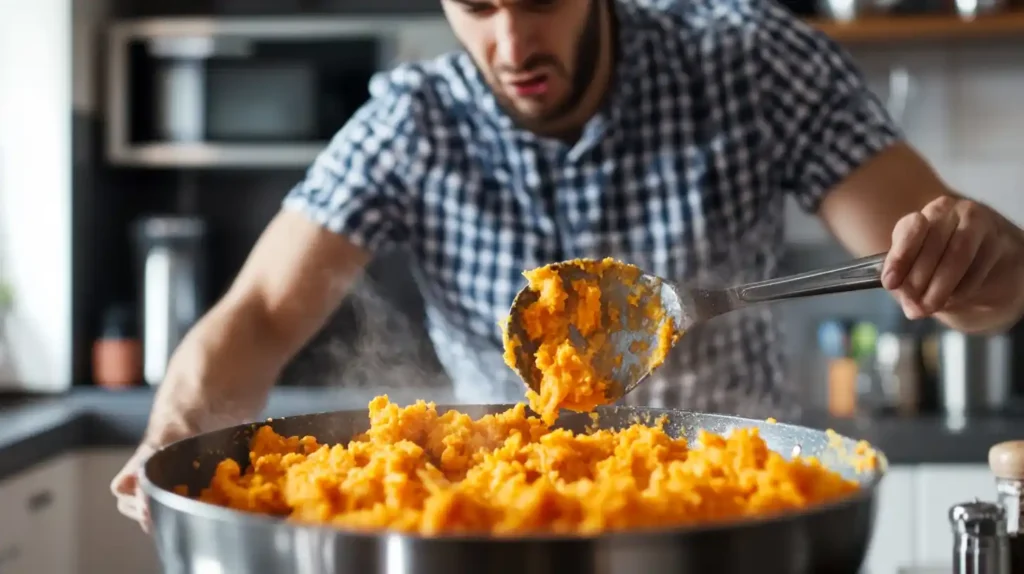
Sweet potato casserole is a classic dish that graces many holiday tables, especially during Thanksgiving. While it’s often topped with marshmallows or pecans, one of the most debated ingredients is the humble egg. Why do so many recipes call for it? What purpose does it serve? And can you skip it altogether?
In this article, we’ll uncover the science behind why eggs are an essential ingredient in sweet potato casserole. From creating a light, fluffy texture to binding the ingredients together, eggs do much more than you might think. Let’s dive into why putting eggs in sweet potato casserole is a game-changer and how you can tweak your recipe to suit your preferences.
The Purpose of Eggs in Sweet Potato Casserole
When it comes to sweet potato casserole, the addition of eggs often sparks curiosity. Are they necessary? Can you skip them? The answer lies in the role they play in transforming the dish from a basic mash into a cohesive, delectable casserole.
What Role Do Eggs Play in Sweet Potato Casserole?
The primary reason eggs are used in sweet potato casserole is structure. Without eggs, the dish can easily turn into a dense, mashed sweet potato blend. But with eggs? The casserole gains stability, holding its shape when served. Essentially, eggs are the glue that keeps everything together.
Eggs help the casserole set properly, preventing it from falling apart when sliced. They act as a binding agent, ensuring that the sweet potato mixture holds its shape rather than collapsing into a pile of mush on your plate. This makes eggs essential if you’re aiming for a more elegant presentation.
Eggs as a Binder: Ensuring the Casserole Holds Together
One of the most important functions of eggs in cooking is their ability to bind ingredients. In sweet potato casserole, eggs serve as the all-important binder that keeps everything together. Think of eggs as the invisible thread that runs through your casserole, weaving the potatoes, sugar, spices, and butter into one seamless dish.
Without eggs, your casserole might end up looking more like a loose, runny mash. The proteins in eggs firm up as they bake, helping the dish maintain its shape. So, if you’re planning to serve neat squares of casserole at your next family gathering, you’ll want to keep those eggs in the mix.
Eggs for Texture: From Mashed to Fluffy
Ever noticed how some sweet potato casseroles have a light, airy texture while others feel dense and heavy? That’s the eggs at work. Adding eggs to your sweet potato mixture creates a custard-like consistency that’s smooth, creamy, and satisfying.
The key is the egg proteins, which expand when baked, trapping air and creating a fluffy texture. This is what turns the casserole from a mashed potato dish into something closer to a souffle. Some recipes even refer to it as a “sweet potato souffle” for this very reason.
If you skip the eggs, you’ll lose this light and fluffy texture, resulting in a denser, heavier dish. That might be fine if you prefer a thick mash, but for those seeking a more refined casserole, eggs are a must.
Why Skipping Eggs Can Change the Dish’s Consistency
While it’s possible to make sweet potato casserole without eggs, the final dish will be noticeably different. Without eggs, the casserole lacks cohesion, making it harder to serve neatly. Additionally, the texture will be heavier and less creamy.
Some vegan or dairy-free recipes omit eggs and use alternatives like flaxseed meal or chia seeds to achieve a similar binding effect. However, these substitutes don’t quite replicate the light, fluffy texture that eggs provide.
In summary, eggs in sweet potato casserole are not just an optional ingredient—they’re what elevates the dish from a simple sweet potato mash to a rich, custardy side dish that everyone loves.
The Science Behind Eggs in Sweet Potato Dishes
Ever wondered why eggs transform a simple sweet potato mash into a delightful casserole? It all comes down to science! Eggs work their magic in several ways, ensuring your casserole comes out perfectly every time. Let’s dive into the chemistry behind it.
How Eggs Affect Sweet Potatoes Structure

The proteins in eggs play a key role in binding the sweet potato mixture together. When eggs are exposed to heat, they coagulate, creating a firm structure that keeps the casserole intact. This process is essential if you want your casserole to hold its shape when cut.
Without eggs, the dish would likely crumble apart or turn into a dense mash. So, if you’re aiming for a cohesive texture, incorporating eggs is a no-brainer.
Moreover, eggs provide that light, fluffy consistency many people love in their casseroles. They act like a leavening agent by trapping air, which helps the mixture rise slightly, making it feel less dense.
Why Eggs Help Create a Souffle-Like Texture
When mixed into the sweet potato mash, eggs introduce air pockets into the dish. As the casserole bakes, these air pockets expand, giving the dish a souffle-like texture. This is particularly noticeable in recipes that involve whipping the eggs before adding them to the mixture.
Want that signature fluffy texture in your casserole? Then, make sure to whisk the eggs well before mixing them into your cooled sweet potatoes. This small step can make a significant difference in achieving that perfect, airy bite.
For more tips on getting the best texture for baked goods, check out this guide on fluffy pancake recipes.
Eggs’ Impact on Flavor and Moisture Retention
Eggs don’t just contribute to texture—they also enhance flavor and moisture. They enrich the sweet potato mixture, giving it a creamy consistency without being overly wet or greasy.
When you bake a sweet potato casserole with eggs, you’ll notice that it retains moisture better, preventing it from drying out. The result? A rich, creamy dish that’s still light enough to enjoy a second helping.
When to Add Eggs in the Cooking Process
Timing is everything when it comes to adding eggs to your sweet potato casserole. Get it right, and you’ll achieve that perfect blend of flavors and textures. Get it wrong, and you might end up with scrambled eggs in your dish!
The Importance of Cooling Sweet Potatoes Before Adding Eggs
One of the most common mistakes people make is adding eggs to hot sweet potatoes. This can cause the eggs to scramble, ruining the smooth consistency of the casserole.
To avoid this mishap, always let your mashed sweet potatoes cool to room temperature before incorporating the eggs. Cooling ensures that the eggs blend seamlessly into the mixture without cooking prematurely.
A pro tip: If you’re short on time, spread the mashed sweet potatoes on a baking sheet to help them cool faster.
How to Properly Mix Eggs to Avoid Scrambling
Once your sweet potatoes have cooled, it’s time to add the eggs. But how you mix them matters. Start by whisking the eggs separately in a bowl until they’re fully beaten. This helps ensure that the eggs are distributed evenly throughout the sweet potato mixture.
Slowly pour the whisked eggs into the sweet potato mash, stirring constantly to create a smooth, uniform mixture. This step is crucial for achieving that creamy, fluffy texture without any lumps or scrambled bits.
Looking for more casserole tips? Check out this article on classic casserole recipes for more ideas.
What Happens If You Add Eggs Too Early or Too Late?
Adding eggs too early (before the sweet potatoes cool) can result in a clumpy mixture with scrambled bits. On the other hand, if you wait too long and the casserole is already baking, you’ll miss out on the binding and leavening properties of the eggs.
To get the best results, aim to add the eggs just after the sweet potatoes have cooled but before any other wet ingredients are mixed in. This will ensure a smooth, fluffy, and cohesive casserole.
Variations of Sweet Potato Casserole with and Without Eggs
Sweet potato casserole is one of those dishes that you can easily tweak to suit your taste preferences or dietary needs. Some recipes call for eggs to create a fluffy, soufflé-like texture, while others skip the eggs for a denser, more traditional mash. Let’s explore these variations and how each choice affects the final dish.
Traditional Casserole Recipes That Include Eggs
The most classic sweet potato casserole recipes feature eggs as a key ingredient. Adding eggs to the sweet potato mixture helps to bind the ingredients together and gives the dish a smooth, creamy consistency. These recipes often include butter, milk, brown sugar, and vanilla to create a rich, flavorful base.
Many holiday favorites rely on eggs to achieve that light, airy texture that makes the dish stand out. If you’re aiming for a crowd-pleaser, sticking with a traditional egg-based recipe is a safe bet. For more tips on perfecting casseroles, you can check out this Old-Fashioned Sweet Potato Casserole Recipe.
Alternatives to Eggs: Vegan and Dairy-Free Options
What if you need to make a vegan or dairy-free sweet potato casserole? Luckily, there are plenty of ways to substitute eggs while still maintaining the dish’s integrity. Common egg substitutes include:
- Flaxseed meal mixed with water (a popular vegan egg replacement).
- Chia seeds are soaked in water to create a gel-like consistency.
- Unsweetened applesauce to add moisture and bind the ingredients.
While these alternatives can work well, it’s important to note that they won’t give you the same fluffy texture that eggs provide. Instead, you’ll end up with a denser, mash-like consistency, which can still be delicious but offers a different eating experience.
Sweet Potato Casserole Recipes Without Eggs: How They Differ
If you choose to skip the eggs altogether, your sweet potato casserole will have a thicker, more pudding-like consistency. These recipes tend to lean on other ingredients, like butter and heavy cream, to provide richness and flavor.
While it’s totally fine to make a casserole without eggs, keep in mind that it won’t hold its shape as well. If presentation is important—say, for a holiday dinner—consider using an egg alternative to help the dish stay together.
Common Mistakes When Adding Eggs to Sweet Potato Casserole

Even experienced cooks can make mistakes when adding eggs to sweet potato casserole. From adding eggs too early to overmixing, there are a few pitfalls to watch out for if you want to nail the perfect casserole.
Forgetting the Egg: Why It’s a Common Misstep
One of the biggest mistakes people make is forgetting to add the eggs entirely. This is especially common when cooking in a rush or trying to follow multiple recipes at once. Without eggs, your casserole will likely be dense and less structured, resembling mashed sweet potatoes rather than a casserole.
If you realize you’ve forgotten the eggs after the casserole is in the oven, don’t panic! It’ll still taste good, but it may not have the same light texture you were aiming for.
Adding Eggs to Hot Potatoes: Avoiding Scrambled Eggs
Another common mistake is adding eggs to sweet potatoes that are still hot. Doing this can cause the eggs to scramble, leaving unpleasant chunks of cooked egg in your casserole.
To prevent this, always let the mashed sweet potatoes cool before whisking in the eggs. This simple step ensures a smooth, even mixture and helps you achieve that creamy consistency you’re aiming for.
Overmixing: How to Keep the Casserole Light and Airy
While it’s important to mix the ingredients well, overmixing can lead to a dense, heavy casserole. Once the eggs are incorporated, mix just until everything is combined. Overworking the mixture can knock out the air bubbles that help create a fluffy texture.
For more tips on avoiding common baking mistakes, take a look at our guide to perfecting French toast.
How to Adjust Recipes Based on Dietary Needs
Cooking sweet potato casserole for people with different dietary preferences doesn’t have to be complicated. Whether you’re making it vegan, dairy-free, or gluten-free, there are simple ways to adapt your recipe without compromising flavor. Let’s explore how to tweak your casserole recipe while keeping it delicious and satisfying.
Egg Substitutes for Vegan or Allergic Cooks
If you’re wondering why put eggs in sweet potato casserole when there are substitutes available, the answer lies in texture and structure. Eggs give the casserole a fluffy, cohesive finish. However, if you’re catering to vegans or people with egg allergies, there are several effective alternatives:
- Flaxseed Meal: Mix 1 tablespoon of flaxseed meal with 3 tablespoons of water to replace one egg. This creates a gel-like mixture that works well as a binder.
- Chia Seeds: Similar to flaxseed, 1 tablespoon of chia seeds soaked in 3 tablespoons of water makes an excellent egg substitute.
- Unsweetened Applesauce: Use 1/4 cup of applesauce per egg for a moist, sweet alternative that works great in sweet dishes.
While these substitutes help bind ingredients, remember that they won’t create the same airy texture that eggs provide. The result will be denser but equally flavorful.
Adjusting Cooking Times and Ingredients
When using egg alternatives, you may need to adjust your baking time. Casseroles made without eggs tend to bake faster, so start checking for doneness about 10 minutes earlier than the original recipe suggests.
Additionally, consider adjusting the amount of liquid ingredients. Since eggs add moisture, reducing milk or cream slightly can prevent the casserole from becoming too wet.
For more tips on customizing recipes, check out our guide to perfecting casserole recipes with minimal ingredients.
FAQs Section
Many people have questions about why eggs are included in sweet potato casserole and how they affect the dish. Here are some of the most frequently asked questions to clear up any confusion.
Can You Make Sweet Potato Casserole Without Eggs?
Yes, you can! However, skipping the eggs will change the texture of the casserole. Without eggs, the dish will be denser and less cohesive. Using egg alternatives like flaxseed meal can help mimic the binding properties.
What Happens If You Don’t Use Eggs in Sweet Potato Casserole?
If you leave out the eggs, your casserole may lack structure and be more like mashed sweet potatoes. It may also crumble when served, especially if you plan to slice it into neat portions.
Are Eggs Necessary to Make the Casserole Fluffy?
Absolutely. Eggs help trap air in the mixture, which makes the casserole light and fluffy. This is why putting eggs in sweet potato casserole is key to achieving that perfect texture.
What Are Some Egg Substitutes for Sweet Potato Casserole?
Some popular substitutes include flaxseed meal, chia seeds, and applesauce. These options work well for binding but won’t replicate the airy texture provided by eggs.
Conclusion
By now, you’ve probably realized that eggs are a key ingredient in transforming sweet potato casserole from a simple side dish to a creamy, fluffy masterpiece. They do more than just bind ingredients—they give the casserole structure, improve texture, and help it hold its shape when served.
If you’re still wondering why put eggs in sweet potato casserole, think of them as the glue that holds the dish together. Without eggs, your casserole might fall apart or feel overly dense. And while there are several egg substitutes you can try, nothing quite matches the light, airy finish that eggs provide.
Whether you’re preparing a traditional holiday dish or experimenting with new recipes, understanding the role of eggs will help you achieve the best results. So, the next time you make sweet potato casserole, remember that those eggs are doing a lot more than you think!
For more cooking tips and recipes, check out our guide to perfecting French toast casseroles.
Final Tips for Perfecting Your Sweet Potato Casserole
Making a sweet potato casserole that wows your guests doesn’t have to be difficult. Here are a few final tips to keep in mind for achieving the perfect dish every time.
Use Fresh Ingredients
Fresh, quality ingredients can make a huge difference in flavor. Choose fresh sweet potatoes, high-quality eggs, and pure vanilla extract to get the best results.
Don’t Overmix the Eggs
When adding eggs to your sweet potato mixture, avoid overmixing. Overworking the batter can knock out the air bubbles, resulting in a denser casserole.
Cool Your Sweet Potatoes Before Adding Eggs
This is a crucial step! Adding eggs to hot sweet potatoes can cause them to scramble. Always let your sweet potatoes cool before mixing in the eggs to ensure a smooth, creamy consistency.
With these tips, you’ll never have to wonder again why put eggs in sweet potato casserole. The next time you’re in the kitchen, you’ll know to make a perfectly fluffy, delicious dish that everyone will love!

